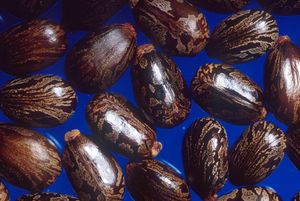Note: This is a project under development. The articles on this wiki are just being initiated and broadly incomplete. You can Help creating new pages.
Difference between revisions of "Ricinus communis - Gandharvataila"
Chaithrika (talk | contribs) (+Common names) |
|||
| Line 23: | Line 23: | ||
Castor oil is also one of the components of Vishnevsky liniment.<ref name="uses6"/> | Castor oil is also one of the components of Vishnevsky liniment.<ref name="uses6"/> | ||
| + | |||
| + | ==Common name== | ||
| + | |||
| + | * '''English''' - Castor oil | ||
| + | * '''Kannada''' - ಹರಳು ಎಣ್ಣೆ | ||
| + | * '''Hindi''' - Arandi Kaa Tel | ||
== References == | == References == | ||
Revision as of 11:43, 1 March 2017
Castor oil is a vegetable oil obtained by pressing the seeds of the castor oil plant (Ricinus communis). The common name "castor oil", from which the plant gets its name, probably comes from its use as a replacement for castoreum, a perfume base made from the dried perineal glands of the beaver (castor in Latin).
Castor oil is a colorless to very pale yellow liquid with a distinct taste and odor once first ingested. Its boiling point is 313 °C (595 °F) and its density is 961 kg/m3. It is a triglyceride in which approximately 90 percent of fatty acid chains are ricinoleates. Oleate and linoleates are the other significant components.
Castor oil and its derivatives are used in the manufacturing of soaps, lubricants, hydraulic and brake fluids, paints, dyes, coatings, inks, cold resistant plastics, waxes and polishes, nylon, pharmaceuticals and perfumes.
Medicine
The United States Food and Drug Administration (FDA) has categorized castor oil as "generally recognized as safe and effective" (GRASE) for over-the-counter use as a laxative with its major site of action the small intestine where it is digested into ricinoleic acid. Despite castor oil being widely used to induce labor in pregnant women, to date there is not enough research to show whether it is effective to ripen the cervix or induce labor. Therapeutically, modern drugs are rarely given in a pure chemical state, so most active ingredients are combined with excipients or additives. Castor oil, or a castor oil derivative such as Kolliphor EL (polyethoxylated castor oil, a nonionic surfactant), is added to many modern drugs, including:
- Miconazole, an antifungal agent.[1]
- Paclitaxel, a mitotic inhibitor used in cancer chemotherapy.[2]
- Sandimmune (cyclosporine injection, USP), an immunosuppressant drug widely used in connection with organ transplant to reduce the activity of the patient's immune system.
- Nelfinavir mesylate, an HIV protease inhibitor.[3]
- Tacrolimus, an immunosuppressive drug (contains HCO-60, polyoxyl 60 hydrogenated castor oil).
- Xenaderm ointment, a topical treatment for skin ulcers, is a combination of Balsam of Peru, castor oil, and trypsin.[4]
- Aci-Jel (composed of ricinoleic acid from castor oil, with acetic acid and oxyquinoline) is used to maintain the acidity of the vagina.[5]
- Optive Plus (carboxymethylcellulose, castor oil) and Refresh Ultra (glycerine, castor oil), are artificial tears to treat dry eye.
Castor oil is also one of the components of Vishnevsky liniment.[6]
Common name
- English - Castor oil
- Kannada - ಹರಳು ಎಣ್ಣೆ
- Hindi - Arandi Kaa Tel
References
- ↑ "Reversible thrombocytosis and anemia due to miconazole therapy"
- ↑ "Gynecologic Oncology"
- ↑ "Circulating metabolites of the human immunodeficiency virus protease inhibitor nelfinavir in humans: Structural identification, levels in plasma, and antiviral activities"
- ↑ "Product Information: Xendaderm topical ointment, balsam Peru, castor oil and trypsin topical ointment"
- ↑ "Aci-Jel (Vaginal Jelly) drug description"
- ↑ "Vishnevsky liniment and ichthammol: on the perspectives of application in military medicine and other fields"
